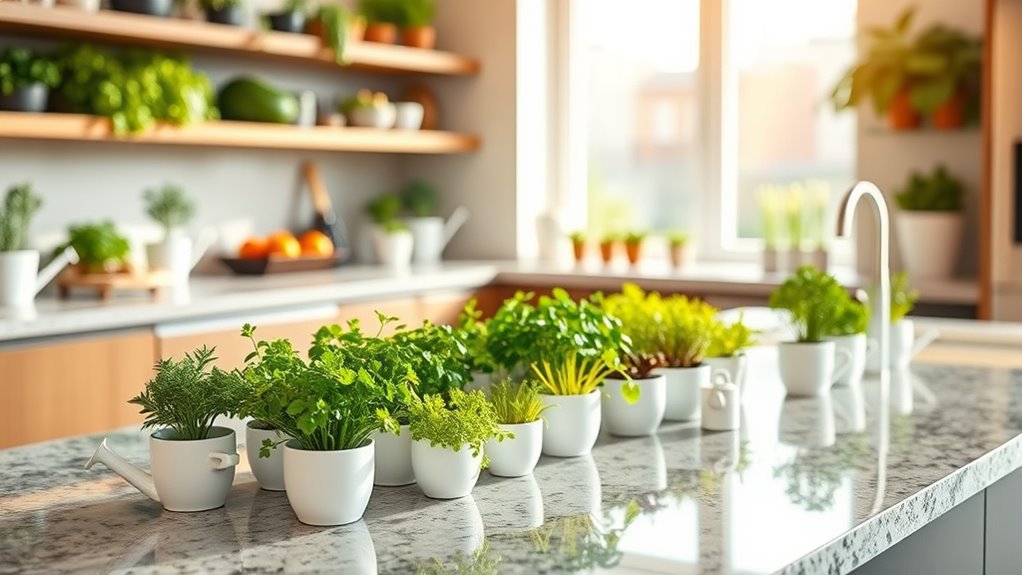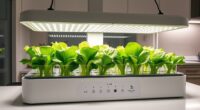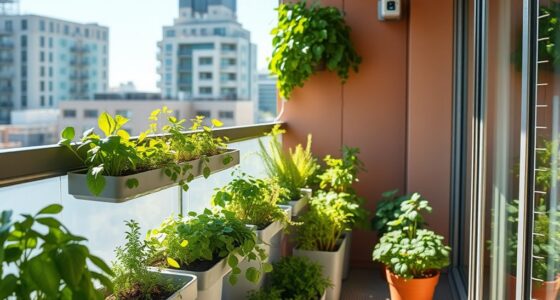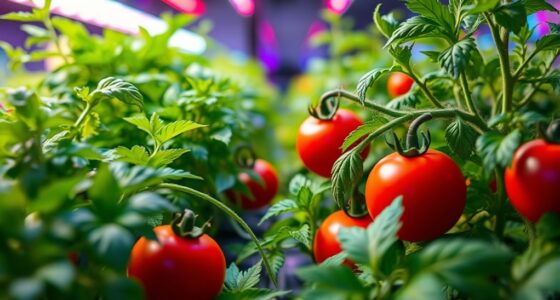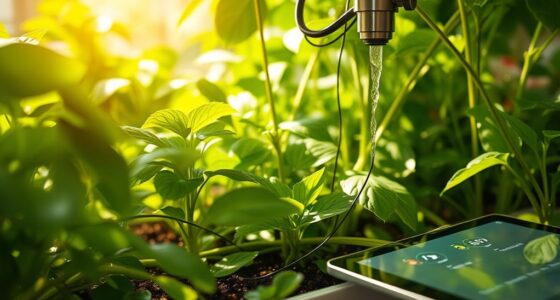Countertop farms are gaining popularity because they make urban gardening easy, sustainable, and convenient. They let you grow fresh herbs and vegetables right in your kitchen using hydroponic systems and LED lights, reducing water use and waste. They’re perfect for small spaces, eco-conscious living, and enjoy flexible, pesticide-free produce. If you want to discover simple steps to get started and enjoy farm-fresh herbs anytime, keep exploring how these compact systems can transform your home.
Key Takeaways
- Countertop farms enable easy urban gardening, making fresh herbs and vegetables accessible in small indoor spaces.
- They promote sustainability by reducing reliance on store-bought produce, packaging, and transportation emissions.
- Their hydroponic systems use less water and eliminate soil, offering eco-friendly, low-maintenance growing options.
- Growing your own food ensures pesticide-free harvests and control over crop quality and freshness.
- They add a green, natural element to home interiors, supporting sustainable living and active engagement in eco-conscious practices.
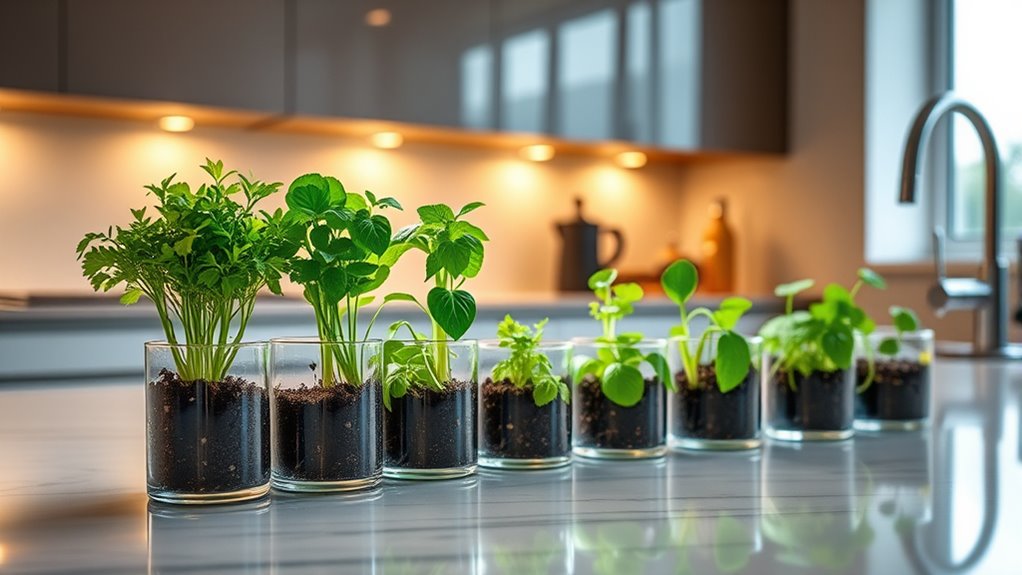
Have you ever considered growing fresh herbs and vegetables right on your kitchen countertop? If not, it’s time to rethink how you approach your food and your impact on the environment. Countertop farms have gained popularity because they blend convenience with sustainable practices, making urban gardening accessible even in small spaces. By bringing your garden indoors, you’re not only enjoying the freshest produce but also reducing your carbon footprint. This trend encourages a shift toward more sustainable living, allowing you to grow organic herbs and vegetables without relying on store-bought options that often involve packaging and long transportation.
Growing fresh herbs and vegetables on your countertop promotes sustainability and easy urban gardening.
Countertop farms are compact and designed for indoor use, making them perfect for city dwellers who want to embrace urban gardening but lack outdoor space. These farms typically use hydroponic systems, which require less water and eliminate the need for soil, making them more environmentally friendly. They often feature LED grow lights that mimic sunlight, ensuring your plants get the necessary light to thrive regardless of the season or weather outside. This setup promotes sustainable practices by minimizing waste, conserving resources, and reducing reliance on pesticides or synthetic fertilizers. Plus, since you’re growing your own food, you control what goes into it, ensuring a healthier, pesticide-free harvest.
Getting started with a countertop farm is easier than you might think. First, choose a suitable system based on your available space, budget, and what you want to grow. Many kits come with everything you need, including seed pods, nutrient solutions, and lighting. Once set up, you can select herbs like basil, mint, or cilantro, or even small vegetables such as lettuce or cherry tomatoes. Regular maintenance involves monitoring water levels, trimming your plants, and ensuring the lights are functioning properly. The learning curve is minimal, and the immediate rewards—fresh herbs for your meals—are worth the effort.
Integrating a countertop farm into your daily routine encourages sustainable practices and adds a touch of nature to your home. It’s an active step toward reducing food waste, lowering your environmental impact, and reconnecting with the origins of your food. Additionally, many countertop farms utilize hydroponic systems, which are highly efficient and conserve water compared to traditional gardening methods. Plus, it makes urban gardening a practical, achievable goal, no matter how limited your outdoor space might be. As more people recognize the benefits of growing their own food, countertop farms stand out as a simple, efficient way to embrace sustainable living while enjoying the freshest produce possible. Whether you’re a seasoned gardener or just starting out, a countertop farm can transform your kitchen into a green oasis and a more eco-conscious space.
Frequently Asked Questions
What Are the Initial Costs of Setting up a Countertop Farm?
The initial cost setup for your countertop farm depends on your goals and budget considerations. You’ll need to invest in containers, lighting, seeds, and nutrient systems. Basic setups can start around $50 to $100, but more advanced systems with automated features might cost a few hundred dollars. Consider your space and desired yield to determine the right investment, ensuring your budget aligns with your farming ambitions.
How Much Maintenance Do Countertop Farms Require Weekly?
You’ll need to dedicate some time each week to maintenance, including watering routines and pest management. Typically, you’ll water your plants regularly, ensuring they stay moist but not waterlogged. Keep an eye out for pests and take quick action if you spot any issues. Regularly cleaning your setup and monitoring plant health will help keep your countertop farm thriving with minimal effort.
Are Countertop Farms Suitable for All Types of Plants?
You might think all plants fit in a countertop farm, but that’s not the case. While they’re versatile, their plant variety and growth requirements matter. Some plants need more sunlight or specific humidity levels, making them less suitable. Think of it as fitting a square peg in a round hole. Before starting, research each plant’s needs to guarantee your countertop farm thrives and keeps you satisfied.
Can Countertop Farms Be Integrated Into Small Apartments?
Yes, you can definitely integrate countertop farms into small apartments. They’re perfect for urban gardening, helping you grow herbs and small vegetables without taking up much space. With space optimization in mind, countertop farms fit neatly on kitchen counters or windowsills, making gardening accessible and convenient. They’re a smart way to bring fresh produce indoors, even in compact living areas, enhancing your apartment’s functionality and your culinary experience.
What Are the Potential Health Benefits of Growing My Own Produce?
Growing your own produce offers numerous health benefits. You can improve nutrient absorption, as fresh, homegrown vegetables often retain more vitamins than store-bought ones. Plus, you reduce pesticide exposure, ensuring cleaner, safer food. When you grow your own produce, you gain control over your diet and can enjoy more nutritious meals. It’s a simple way to boost your health while enjoying the satisfaction of cultivating your own fresh, organic food.
Conclusion
Imagine your countertop as a tiny, thriving farm—just like the one I started last month. Within weeks, I watched fresh herbs sprout, filling my kitchen with life and flavor. It’s like having a garden in a jar, right on your counter. With over 60% of urban dwellers interested in sustainable living, countertop farms make it easy to grow your own food—no yard needed. So why not dig in and start cultivating your own little farm today?
